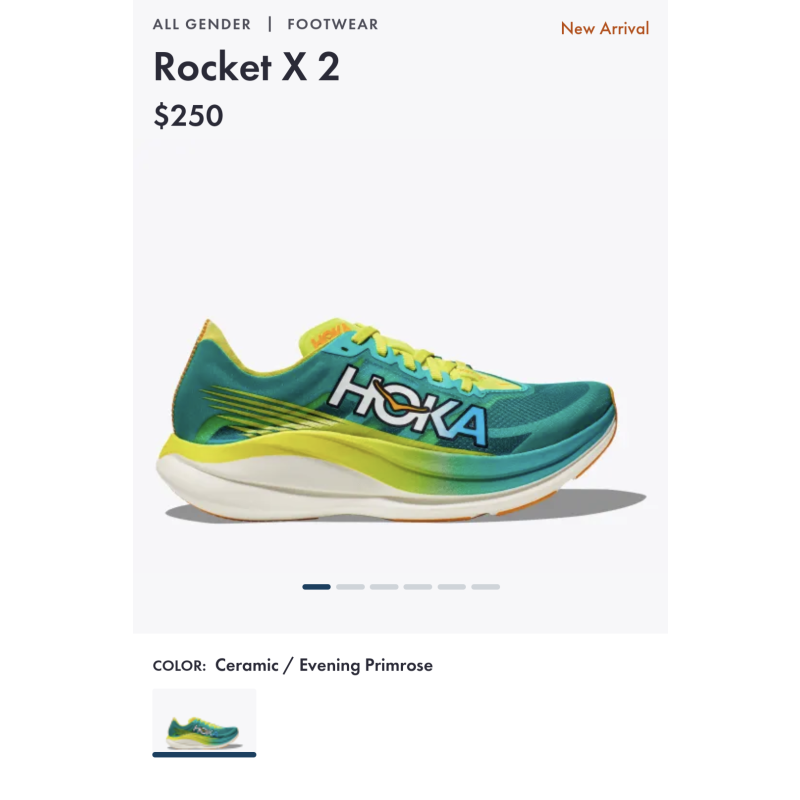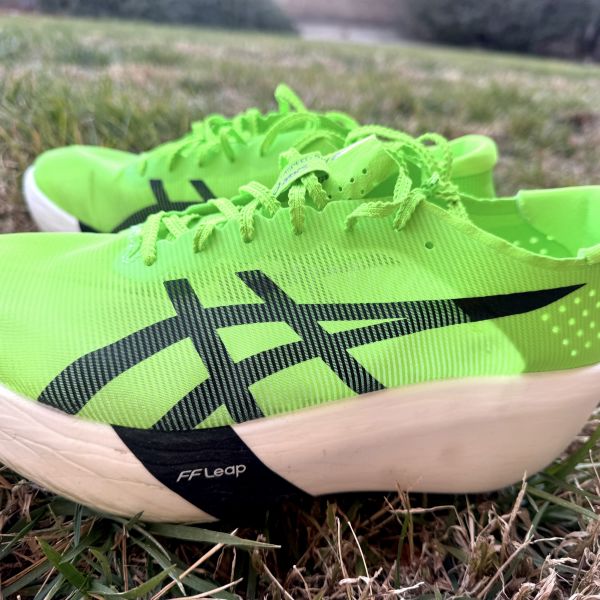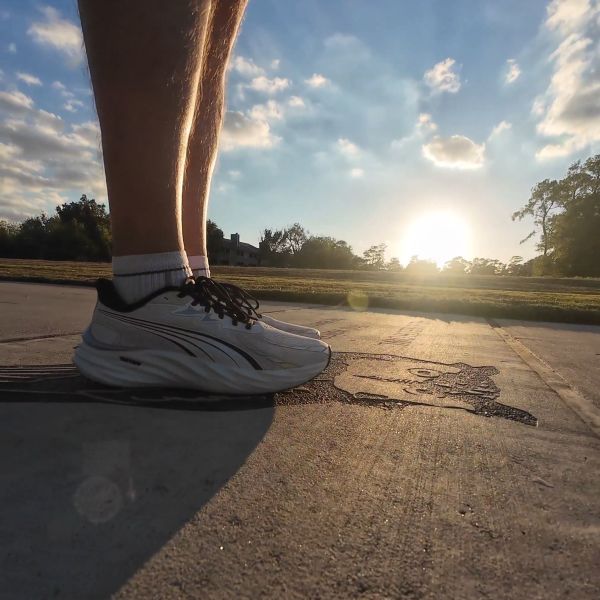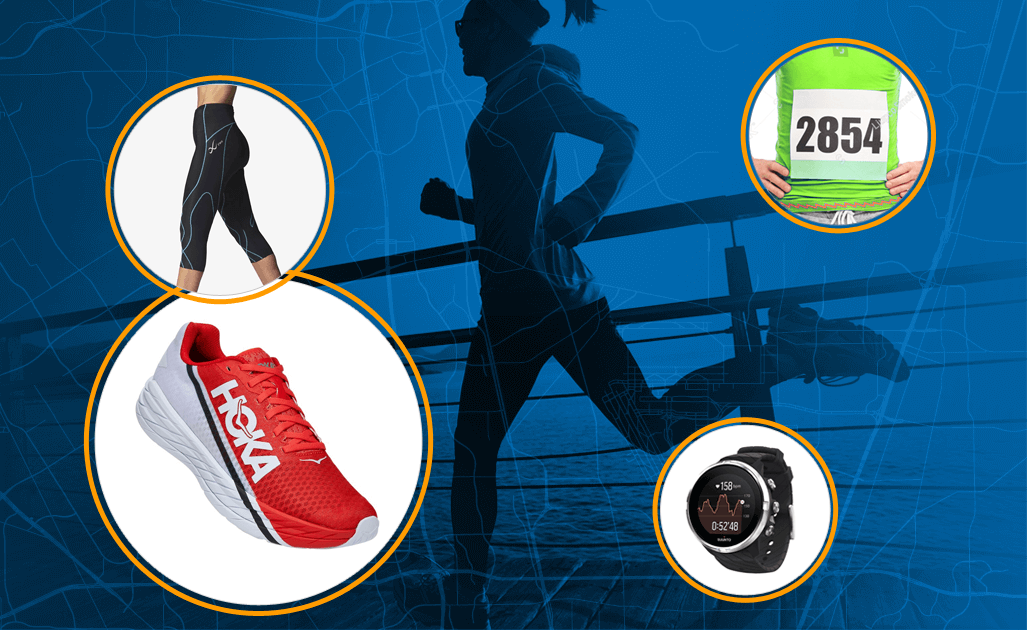
Since their debut in 2016 at the Rio Olympics, carbon-plated shoes have taken the running world by storm. Not just for elite athletes but also drawing a huge market from conventional runners (if they can afford them!) Simply put, carbon-plated running shoes allow the runner to be more efficient, requiring less energy to push off the ground and creating a spring-like effect. Upon learning about these shoes, my interest was piqued. Not only do these shoes include energy-saving engineering (my field of study) they are propelling the human boundaries of running forward. Since I am striving for better times and love any opportunity to analyze my workouts, I acquired a pair of HOKA Rocket X2’s through a promotion from Ironman that involved signing up for a race to obtain a free pair of any type of HOKA shoe! What a deal! Now I have a race to train for and a new pair of carbon shoes. In the spirit of appreciating these high-tech shoes, I have tailored this review to analyze metrics taken from my runs within a similar time frame while running with and without the HOKA Rocket X2 shoe. Data pulled from my Garmin profile allowed me to create graphs depicting the differences in these runs. I also review aspects of the shoe, so let’s get started!
Starting with the details, I am intrigued by the fact that the HOKA Rocket X2 is an all-gender shoe with sizes listed for both women and men on the website. The shoe weighs in at 8.3 ounces or 236 grams. The heel measures 36mm, and the forefoot measures 31mm, resulting in a relatively low heel drop of 5mm. This lower heel drop is attractive to me as a runner since I am working on improving my running stride and transitioning to a lower heel drop. Check out this article for more information on running shoe fits and heel drops!
A significant upgrade from the previous Rocket X model is the dual-density PEBA (polyether block amide) midsole. This type of foam is used in the super shoe lines of many brands, including Nike, Saucony, Mizuno, and Under Armour. The foam offers excellent reactivity while maintaining a lightweight design. The shoe material is made of a light plastic material, which gives it water-resistant properties but diminishes its breathability. However, its main goal is to provide a lightweight design. While it lacks breathability, it also offers minimal support and may feel slightly flimsy upon initial wear.
Lastly, the sole features a scooped carbon fiber plate that starts in the heel and extends across the foot in a forked configuration. A bonus feature is HOKA's use of recycled polypropylene for the laces!
Going into this shoe trial, I had no expectations. I didn't know anyone who had run in them before, and I only lightly researched why the carbon plate is beneficial. Over the past year, I have focused on improving my running form, and combining better form with a carbon-plated shoe can bring significant improvements to your training. I took the HOKA Rocket X2 on its first trial run along my favorite 5k route, which follows an asphalt bike path near Sacramento. I am a creature of habit and truly enjoy running the same routes during my training to create distance markers along the way.
This path was the perfect place to try out the road-racing HOKA Rocket X2, and as I took that first step out of my apartment, I knew it was going to be a stellar run. My initial impression was how tall I felt in these shoes, and as a tall individual, this is a recurring theme in my reviews. The extra bounce added to my stride made me feel like I could easily dunk a basketball (are they making carbon-plated basketball shoes yet?).
As I progressed through the run, I felt a harmonious connection between the ground and the shoes, providing me with maximum energy return. I could literally feel the energetic synergy between the shoe and the ground, and it was a remarkable sensation. There is no doubt that these shoes work with you to reduce energy expenditure, but their ultra-reactive sole demands extra attention to the running surface. I became hyper-aware of cracks, slopes, and imbalances along the bike path. These shoes don't offer much ankle support, and with minimal cushioning in the foot insertion area, it's up to the runner to be mindful of their steps and running surface. The shoe is a bit narrow as well and I needed to adjust the lacing to remove pressure from the wider areas of my foot. I ordered the shoe in my typical size (W 11) and there might be more room if you order a half size up!
In comparison to my usual training shoes like the Altra Via Olympus, which boasts a well-cushioned ankle area, I felt a little unbalanced in the Rocket X2. However, continuing to train with this shoe has made me slightly more confident. Additionally, I developed small blisters on my Achilles for both feet due to the thin material pushing my thin ankle socks down and creating friction.
Now that we have covered the specifications and overall impressions, I want to delve into how the HOKA Rocket X2 can enhance your running. The carbon plate improves efficiency but can also alter your stride length and cadence. If you have ever heard a coach or read a running blog discussing increasing your cadence to improve your pace, there is scientific evidence behind that concept. Although these numbers vary based on individual factors, it is commonly suggested that an ideal cadence is around 180 strides per minute (spm). Personally, I have rarely recorded a cadence close to this; my average cadence hovers around 165 spm. This aligns with the idea that a person who is 6 feet tall will have a cadence 18 spm lower than someone who is 5'6" when running at the same speed. There is a relationship between cadence and stride length: as you increase your cadence, you will notice a shorter stride length compared to a lower cadence, which has a longer stride relative to your height at the same speed.
Furthermore, when examining stride length, the variability depends on your height. The general formula for this biometric suggests that stride length should be roughly proportional to the square root of leg length. Did I just measure my leg length to calculate this? You bet!
Let's examine the numbers. I selected four different runs, all conducted on the same bike path, to compare distances while wearing either the HOKA Rocket X2 or an alternative training shoe. Since I completed these runs before considering a comparison article, it's important to consider the differences in the distance when reviewing the metrics. I extracted data from runs that were either time trials or aimed at achieving a specific fast pace. While this approach may not be as scientifically rigorous, it still yields interesting results that were not biased by my awareness of using the data for comparison.
Another factor to consider is that the runs with the HOKA Rocket X2 were completed within a three-week period after finishing a personal record 70.3 Ironman race. Additionally, all of these runs were part of training blocks for a 70.3 triathlon.
The runs completed in my alternate training shoes are depicted in blue, while the HOKA runs are represented by an electric green color, chosen to emphasize their vibrancy (selecting the right color for these graphics is crucial).
First, let’s look at the metric that most people are familiar with - running pace. I ran my fastest recorded mile in the HOKA Rocket X2 (6:24 /mile) during the 3.1-mile run. As the distance increases the pace increases with my 6.22-mile run pace clocking in 15 seconds faster than my HOKA run at 7.06 miles.
Looking at average cadence, I had the same averages for my 3.1 and 4.06-mile runs while my 6.22-mile run in my other training shoes had a higher cadence than the HOKA Rocket X2 by 8 spm difference.
When reviewing max cadence, all the values are about the same with the highest cadence coming from the 6.22 mile run. This is a harder metric to analyze since I don’t know how long I was maintaining this cadence- was it only one minute or six minutes?
For the stride length analysis, my stride ranges from 1.27-1.43 meters resulting in a 0.16-meter difference. How does that look for those of us familiar with the imperial system, that is a 6.2-inch difference and these differences were between the HOKA and my regular training shoe. When comparing my shortest stride length (1.27 m) it is linked to my highest average cadence (167 spm) that follows suit to what was discussed earlier.
Overall, this shoe is bound to make your runs feel different. In terms of metrics, more running data is needed but my overall fastest mile has come from running in these shoes. If you want to experience better run efficiency and improve your pace, I would recommend buying these shoes. They are not to be used for everyday training but for time trials and races for sure!
I found it interesting to review these metrics and going forward I will continue to track my progress with the Rocket X2. Have you ever looked at your run analytics? What metrics do you usually focus on? Leave a comment below!
David Moore Great analysis of cadence and stride length in the plated shoe Natalie! Cadence is a metric I often focus when running flat surface. I've even experimented with a metronome during training runs to focus on that 180 spm.
Michael Vaughan Loved all your data. I also did a reviewed the RX2 and 💯 agree with your cons. (Wish we could give half stars as it is really a 4.5 IMO) I'm going to have to dig down in all my metrics and take a look. From my raw data, (now I ONLY have Hokas) my half marathon showed my greatest improvement.
Natalie Rizzo Im super excited to dig more into the data! And Micheal- I also wanted to give it 4.5, it’s such a good shoe! Maybe something the WeeViews team can make possible in the future :)
Login to your account to leave a comment.






We Want to Give it to You!
